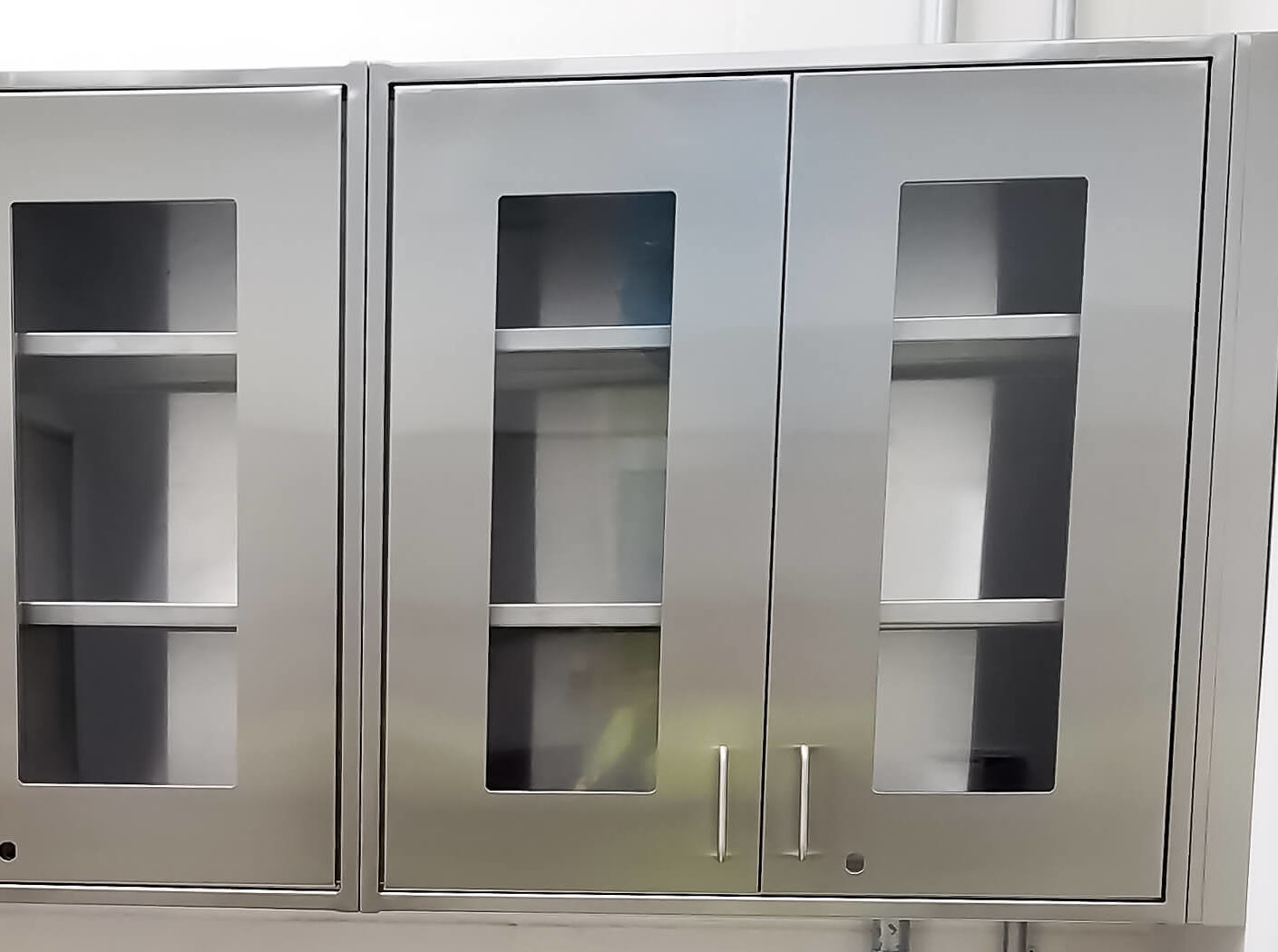
Many labs manufacture and create products and pharmaceuticals that require specific environmental conditions during production. Cleanroom design goes beyond simply creating a controlled environment for conducting lab work.
Rather, cleanrooms are designed specifically to minimize the presence of foreign and unwanted particles during the experimentation and manufacturing of pharmaceuticals. In this article, we will focus on how to design a cleanroom environment specifically when dealing with pharmaceutical chemistry lab equipment and furniture, and some of the steps you should take during the process to help keep you on track.
Environmental and Location Considerations
Before you start designing a cleanroom, you should make sure your space is appropriate and determine what you will need for your lab’s specific work. Understand that you must meet specific environmental and location requirements for your cleanroom to be successful.
1. Location
As most cleanrooms are a vital part of a larger chain of operations, considering where in your lab to host your cleanroom is vital. Proximity to vibration or high-powered machinery may cause shifting or unexpected particle fluctuation, so a low-vibration site is preferable.
Similarly, placing your cleanroom close to high-traffic areas of your lab, or near spaces with higher contamination rates will put the equilibrium of your cleanroom at risk.
2. Evaluate the Space
Once you have determined the location of your cleanroom, you should carefully examine the space you have chosen. Your chosen room should be able to support all processes within the cleanroom and should be large enough to provide ample opportunity and space for all personnel, equipment, furniture, and airflow.
While it will be easiest to design a regularly shaped room, all layouts can be used as long as they afford ample your team the space and safety they require.
To avoid cross-contamination, some cleanrooms may require a single access point. By minimizing the number of access points to the cleanroom, you can protect vulnerable processes from airborne material inflow.
Some labs opt for air locks to protect critical spaces, direct both entrance and exit flow to avoid cross-contamination, or create systems for managing personnel traffic. An ante-room is another solution to maintaining cleanliness.
An ante-room is a room that exists between the cleanroom and any other un-rated area. Airlocks and ante-rooms help lab staff avoid opening unclean spaces and cleanrooms at the same time, reducing the risk of contamination.
By choosing a space that can accommodate all of these requirements, your cleanroom design will already be off to a great start.
3. Choose a Cleanliness Classification
Cleanrooms are assigned ‘levels’ of cleanliness based on standards created by the Institute of Environmental Science and Technology. Once assigned a cleanliness classification, cleanrooms must maintain environmental conditions in order to maintain an acceptable level of present particles.
Each cleanliness classification specifies the number and size of acceptable particles that may be present, and can greatly impact the kind of work that can be conducted within the room. To determine what cleanliness classification your cleanroom will require, consider the needs of your particular work and the standards you need to meet.
Pharmacy cleanroom design must comply with FDA regulations, so will require a more stringent cleanroom classification.
Here is where proper design planning comes into play. The ideal finishes, layout, entrance regulation and more will depend on what cleanliness designation you are attempting to maintain.
The regulations with which you will need to comply will be entirely dependent on your industry, and the requirements of the products you create. To avoid cleanliness risks and issues down the line, learn all you can before you start the process of building your cleanroom.
4. Air Change
As mentioned above, when considering layout, airflow and air change are extremely important elements in cleanroom design. Most important in the pre-construction and planning phase is considering what spaces will be open to one another.
In order to help create the most stable cleanroom environment possible, ensure in the planning process that no cleanroom will be exposed to an environment more than two designations below its own. Here again, you should consider how personnel will enter and exit cleanroom spaces, what sort of mechanisms can be put in place to avoid contamination, and whether or not an airlock or anteroom may be appropriate.
Some pharmaceutical cleanroom designs may require pass-throughs, windows, or gowning rooms. Additional windows can provide needed safety supervision opportunities and reduce the need for non-vital personnel to enter cleanrooms.
A pass-through can allow for the exchange items without fully exposing a cleanroom to a non-clean area. Pass-throughs can be custom created for the needs of the lab depending on the size, shape, and location requirements.
A gowning area may also be necessary. Here you can provide your personnel with a space in which to store, dispose of, and dress in gowns and proper lab attire without cross-contamination.
Construction and Materials
Once you have laid the groundwork for your cleanroom, you can begin the construction process. There are a myriad of material and finish options to choose from, each with its own unique properties.
Depending entirely on the requirements of your cleanroom, everything from floor to ceiling will need careful consideration.
1. Floors
Pharmaceutical cleanroom designs often include renewal or change of flooring materials. Ideally, you will choose materials that can stand up to different types of substances and even absorb spilled or dropped chemicals.
Vinyl sheeting welded into place and fused to become seamless is a popular choice among lab designers for its resilience to chemicals, solvents, and cleaning agents. Other designers opt for epoxy, which offers a similar chemical and solvent resistant surface.
Other cleanroom designers prefer flooring materials designed to discharge electrostatic charge, especially in environments that may be more sensitive to static or electricity. In these cases, labs might install grounded conductive flooring to reduce or eliminate this risk.
Another common addition to cleanroom flooring is a minimum 4” cove where walls and floor meet. This smooth rubber coating helps in the process of cleaning, preventing contaminants, chemicals, and foreign objects from building up in cracks.
2. Walls
Whether you already have a room capable of being converted into a cleanroom, or need to create the walls you will use to enclose your room, there are several options available to you. While basic steel stud and gypsum board construction are commonly used and a viable option, you are not limited to this traditional method.
Many labs are beginning to utilize modular wall systems that can be moved or restructured to change the cleanroom space at a later date. Other labs are opting for concrete block construction, a great option if you want to finish your walls using an epoxy.
No matter what type of wall construction you decide on, one of the most important factors to consider is the finish. Smooth, non-shedding, and smooth surfaces are essential for any cleanroom design.
Aluminum panel or coated steel finishes are growing in popularity as they are easy to clean and chemical resistant. Epoxy paint, polyurethane, and baked enamels provide non-porous finishes that prevent flaking and buildup and are all appropriate cleanroom wall finishes.
Here you should also consider semiconductor cleanroom design; environmental control is of the utmost importance, so the selection of finishes will need to be done carefully. Another integral part of cleanroom wall construction is the addition of rounded corners.
Sharp corners invite the buildup of contaminants, chemicals, and unwanted residue where rounded corners allow for fast and easy cleanup.
3. Ceilings
As is the case with cleanroom walls, ceiling finishes must comply with sanitation regulations. If your cleanroom has a suspended ceiling, all panels must be sealed to prevent drastic leakage or air pressure changes.
Finishes can be used to fill in cracks and porous materials in areas of your cleanroom that require more frequent sanitization. Additionally, rounded corners and smooth ceiling design will help make wall and ceiling cleaning simple.
You should also consider lighting and filtration. The specific requirements for filtration and lighting will depend on the unique needs of your lab and staff, but some general rules still apply.
Keeping cracks and leakage opportunities to a minimum, all accessories and filtration added to ceiling construction should be sealed and properly finished to help maintain proper levels of sanitation.
4. Doors
As previously mentioned, depending on the unique needs of your cleanroom, you may require airlocks or ante-rooms for contamination prevention. You will also require emergency exits and general entrances.
Regardless of which doors you are focused on, here again, the finishing materials and specs matter. Emergency exit doors will need automatic locking mechanisms to prevent outside entry; however, you should also be able to open them from within.
Emergency exit doors should also be equipped with a crash-bar mechanism that will sound an alarm to notify the rest of your lab of an emergency.
Door finishes that shed or are particularly porous are not recommended, as these can contribute to contamination and contaminant build-up over time. As with ceilings, walls, and floors, the doors of your cleanroom should be finished with smooth, non-shedding, chemical resistant products.
All doors going in and out of your cleanroom should be fitted with self-closing mechanisms to keep air exchange at a minimum, and sealants should be utilized to help prevent leakage.
Furniture
Once your cleanroom has been constructed, you are ready to begin filling it with the necessary equipment and furnishings. Integral to the proper conduction of experiments and production of pharmaceuticals is the presence of appropriate workspaces.
As with wall, ceiling, and floor finishes, all cleanroom furniture should be non-shedding and rated to withstand contact with harsh chemicals and solvents. Here, you are able to customize your cleanroom space efficiency and the comfort of your staff.
1. Tables and Workbenches
Cleanroom Tables and lab workbenches are an essential part of everyday life in a lab, and often act as the stage on which to perform experiments and vital data analysis. Depending on what type of work is conducted in your lab, you have several options to choose from.
OnePointe Solutions creates amazing tables and workbenches with the unique needs of every lab in mind.
Labs in which work surfaces may be exposed to higher levels of moisture may benefit from epoxy resin or phenolic resin finishes, both of which are resistant to and hold up well against moisture. ESD laminate is designed to prevent static electricity discharge, so may be better for labs in need of static resistant finishes. Stainless steel is a classic option for labs where bacteria buildup or porous surfaces could be a concern.
2. Storage and Cabinetry
From storing chemicals and potentially harmful substances to personal belongings, every cleanroom needs ample and sturdy storage. Here again you should consider the specific needs of your lab.
Custom casework, storage, and cabinetry can be designed to fit your space and with specific items in mind, so consider what exactly you will need to store in your cleanroom.
Many cleanrooms house storage units designed for specific environmental conditions or products requiring steady temperatures. Some may require cabinetry with locking mechanisms for more secure storage.
Other cleanroom designs may incorporate sterilization cabinets, designed to sterilize and store equipment between uses. Regardless of what you specific requirements are, OnePointe Solutions can work with you to design the perfect storage system for your cleanroom.
3. Fume Hoods
The addition of fume hoods in a cleanroom environment can aid in the maintenance of clean designations and particle presence. Fume hoods provide important filtration and ventilation in environments in which acrid fumes or harmful chemicals may cause environmental or health risks.
Fume hoods can help keep your cleanroom cleaner, and aid in the overall cleanliness and comfort of your facility.
Contact Us at (866) 216-3106 for Laboratory Design Solutions.


